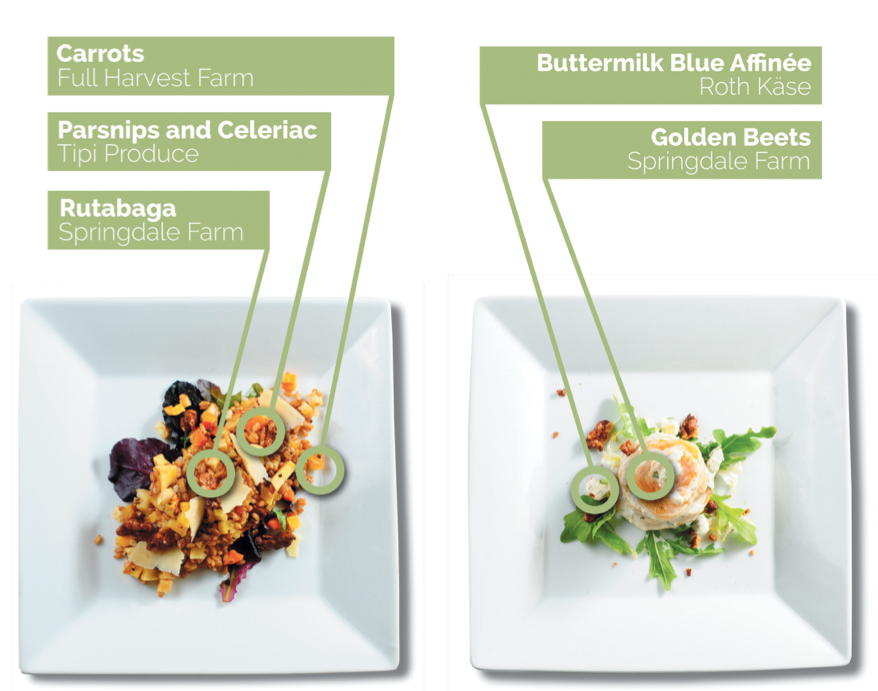Back of the House: If They Plant It, We Will Eat
It’s 5 o’clock. Do you know where your dinner came from? Diners who order the New York Strip Fajitas at Café Corazon in Riverwest do. The beef comes straight from the owner’s family farm in Waupun, Wisconsin. In Bay View, the burger at HoneyPie is made with Wisconsin grass-fed beef and a sunny side egg from Yuppie Hill Farms in Burlington. Even a salad at Palomino Bar is piled high with local greens from Milwaukee’s Growing Power. How do customers know? It’s up there on the blackboard.
Farm-to-table, whether you’re tired of the phrase or not, is gaining momentum in Milwaukee, and it’s just as much of a marketing tool these days as it is a philosophy. It’s redefining the way we eat, the way we shop, the way we read a menu. But what does it mean?
In the restaurant world, it simply means the chef can tell you what farm the carrots in your soup came from. But who’s asking?
Folks like Stacy Tornio, that’s who. The 33-year-old wife and working mother of two was overjoyed when she finally got the kitchen appliance of her dreams—a deep freezer.
“Now I can get my meat,” Tornio said.
Late last summer, she made the 20-mile trip from her Greenfield home to MoonShine Acres in Mukwonago, where she picked up a quarter steer and half a Berkshire pig. “It’s not any cheaper than what you would find in the supermarket, but I know the animals are raised naturally without hormones or antibiotics, and good meat like that is hard to find,” she said. “Plus, I get to tell them how much bacon I want.” It’s safe to say the Tornios do a lot of home cooking, but that’s not to say they don’t take advantage of Milwaukee’s broad-based culinary scene. And when they do, knowing where their food comes from makes a difference.
The Tornios aren’t alone. The quest to eat more locally-grown produce and sustainably-raised meat is gaining popularity. Between 2002 and 2007 local food and farmers markets were among the fastest-growing segments of agriculture in the United States, according to the latest Census of Agriculture, with sales rising by nearly 50 percent. By 2012, a mere 10 states accounted for more than half of the country’s nearly $7 billion in local food sales—and Wisconsin ranked No. 8.
All in the Roots
It was during this early surge of farmers market frenzy that aspiring restaurateur Chef John Raymond seized the opportunity to fulfill his decade-long dream. Inspired by the pioneering efforts of Alice Waters’ Berkeley, CA farm-to-table restaurant (founded in 1971) Chez Panisse, Chef John teamed up with farmer and friend Joe Schmidt in 2005 to open Milwaukee’s first chef/farmer-owned restaurant—Roots.
“The goal was to produce as much as we could with our own hands,” says Chef John. “It’s how I grew up, and I have such an intense passion for food and respect for the land. I could talk about it for hours,” he says over the phone as he begins to boil water for his 11-year-old daughter’s spaghetti dinner. “I’m not interested in recipes, though. When I read about food, I want to know its history, its origin, where it comes from.”
At Roots, it wasn’t enough to be just another farm-to-table. “Seed-to-plate is what I like to call it. We were planting, growing and harvesting what we were plating. That was such a beautiful thing,” says Chef John, speaking about Roots in the past tense. It’s been almost two years since he stepped away from “his baby,” turning it over to developer Tim Dixon in what he calls a mutual transition. After a couple dozen years in the restaurant business, it was time… “These are the days I want to spend with my daughter,” and late nights in a restaurant, coupled with the hardships of farming, leave little time for that.
Within weeks of the restaurant’s closing, Dixon recruited the former bookkeeper at Roots, Gina Gruenewald, to open a new restaurant in the same space perched on Hubbard St. in Brewer’s Hill. With the help of numerous Roots’ employees, including Executive Chef Dan Jacobs (now moving to Odd Duck), Gruenewald opened Wolf Peach, a communal-style dining experience that carries on the spirit of sourcing from local artisans and farms.
Today, Wolf Peach joins a prosperous collection of farm-to-fork restaurants, a sign that Farmer Joe Schmidt and Chef John Raymond did what they set out to do, planting a seed-to-plate concept that Milwaukee diners would continue to sustain. La Merenda in Walker’s Point (2007), Meritage in Washington Heights (2007), and HoneyPie (2009) and Odd Duck (2012) in Bay View market to customers with “inspired by local ingredients”-style descriptives while packing tables.
Building the Support Network: The RSA Model
While Roots was introducing Milwaukee diners to the farmer-chef model, another aspiring restaurateur was busy building an infrastructure that would soon offer multiple, chef-owned restaurants convenient access to locally sourced food—minus the travails of growing it on their own.
In 2008, the Buy Local, Buy Wisconsin (BLBW) grant launched as part of Governor Jim Doyle’s budget with an initial $225,000 to propel local food sales. Among the recipients was Chef Dave Swanson, who at the time was four years into his traveling cooking school business (now called Braise Culinary School), a venture that took participants out into the fields, orchards and forests for a hands-on course that literally “connected people to their food,” a familiar motto for anyone who knows Chef Dave.
The BLBW was just the funding Swanson needed to launch his next big idea: a Restaurant Supported Agriculture (RSA). The concept is based loosely on a CSA, or Community Supported Agriculture, which allows members to buy a share from a farm in exchange for weekly or biweekly crops. But unlike a CSA that typically relies on produce from a single farm, chefs who buy into Swanson’s Braise RSA enter into an alliance of Wisconsin farms.
Swanson recognized early on that there was no easy way for restaurants to source locally without a considerable amount of work. Researching farms, arranging deliveries, and adapting the menu based on supply are all added hurdles—and added costs.
“Farmers don’t always have time for all those deliveries, either,” he adds.
Not to mention the great deal of planning that goes into servicing a restaurant with specific crops and meats. And what about farms that are at capacity? They might not be able to afford the extra labor for growth, but … perhaps they could benefit from a market for end-of-season surplus. Also, if crops from one farm are damaged, relationships are already in place for another farm to fill the order. That’s part of the thinking behind the RSA. It’s a network of farms with diversified offerings marketing to chef-owned restaurants in the Milwaukee area.
To get the program up and running, Swanson met with willing chef participants to gauge their needs for the season. From there, he was able to match chefs with the best possible growers, drawing from the nearly 40 intimate farmer relationships he built while working with various restaurants and through his cooking school. During the winter months, he met with each farm individually to place the restaurants’ orders before planting season. Payments were made to the farmers upfront to help them avoid short-term loans with higher interest rates and improve their pre-season cash flow.
By the end of its first season, the RSA was a win-win-win for not only restaurants and farms, but for the consumers. Members like Chef Jan Kelly at Meritage can keep the emphasis of her blended, seasonal menu on local ingredients. “It’s a way for us to get back to serving real food,” Kelly says. “And it makes my life as a chef a lot easier. I love to talk to farmers; I have such respect for what they do, but boy it’s a lot of work to visit and research farms. The RSA does the homework for me so I can spend more time in the kitchen, where I love to be.”
And the farmers can spend more time on the farm. “It means fewer phone calls and a one-stop delivery for us,” says April Yuds at LotFotL Community Farm, one of the Braise RSA farms in Elkhorn, Wisconsin. “Sometimes we have to settle for a lower price, but now we have a market for veggie seconds and some of the harder-to-sell, more unusual items.”
The added support from area chefs to farms like LotFotL (which stands for Living Off the Fat of the Land) goes beyond dollars. “As farmers, we work crazy hours,” says Yuds. “But I try not to keep track. If I do, I realize some days I’m working for something around $1.50 an hour. But I’m not expecting my wage to come in the form of a paycheck. It’s the lifestyle that comes with it that makes farming the most rewarding and enriching job I have ever done.”
Today, the RSA program that started with a couple dozen farms and a handful of area restaurants—now including Swanson’s very own Braise, which opened in Walker’s Point in 2012—currently includes more than 400 farms and 20-plus chefs. In its first year, the RSA generated nearly $110,000 in new sales of local farm produce and created a market for 90 unique products, according to the BLBW 2008/2009 Annual Impact Report. The model has been so successful that schools and other organizations with similar interests have turned to Swanson for guidance.
“I think it’s great that colleges and other institutions from around the country are recognizing what we’re doing, but it’s difficult for me to help. This is a model specific to us,” he says. “What works in Wisconsin might not be the best approach for an area like, say, Texas.”
The RSA dynamics—a collaborative effort with sustainability and sharing at its core—have bound Swanson and the member chefs into a tight-knit group who have learned to overcome the challenges that come with farm-to-table service.
“We might get in a whole steer and break it down so that HoneyPie and Comet get the cuts they need, or Jan at Meritage might be looking for something in particular,” he says. “We’re not worried about competition among us. If you give 10 chefs a carrot and tell them to create something, you’re going to get 10 very different dishes.”
Special thanks to Chef Jan Kelly of Meritage for providing the beautiful menu items for our graphic.
From the Ground … Up the Corporate Ladder
Since closing the doors to Roots in 2012, former owner and chef John Raymond is keeping his hands in the dirt while lending his culinary talents to Bon Appetit. But if you’re thinking about the foodie magazine, guess again. Although Roots was once recognized by the esteemed culinary publication, here we’re referring to Bon Appetit Management Company (BAMCO), a refreshing farm-to-fork venture in the food service world.
The company provides café and catering services to corporations and universities in more than 30 states, including Wisconsin, where it services thousands of employees at the Kohl’s corporate campuses in Menomonee Falls. They source ingredients for their seven cafes with seasonal menus from small, owner-operated farms and ranches from within a 150-mile radius.
“Essentially, I’m a forager,” says Chef John. “I seek out the best producers in the region.”
In 2011, Bon Appetit Co. arrived at their desired milestone in the Farm to Fork program, reaching 1,000 contracts with small farmers, fishers and food artisans from around the country—a target hit thanks to the company’s decision to hire designated foragers.
But if you ask Chef John if he misses the restaurant business, he’ll tell you, “Yes... No... Maybe some days I do. I mean, it’s a different lifestyle with a lot of late nights. For now, I’m enjoying spending the extra time with my daughter.” And being in a position to bring from-the-ground ingredients to the masses?
“Well that’s kind of amazing, too.”







